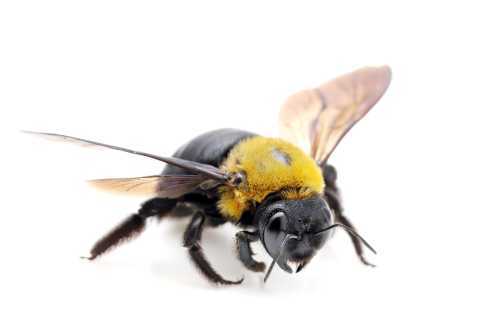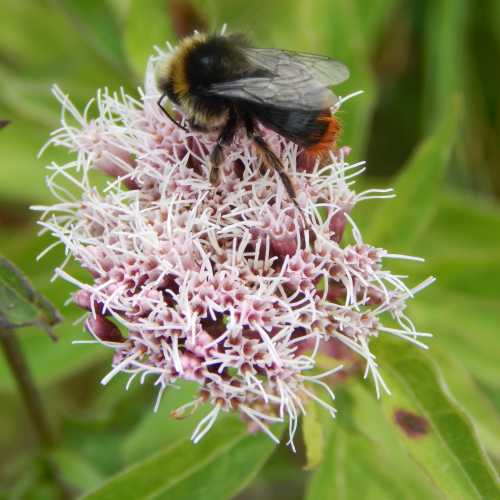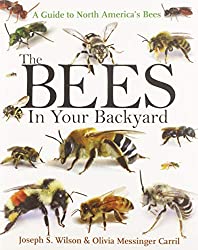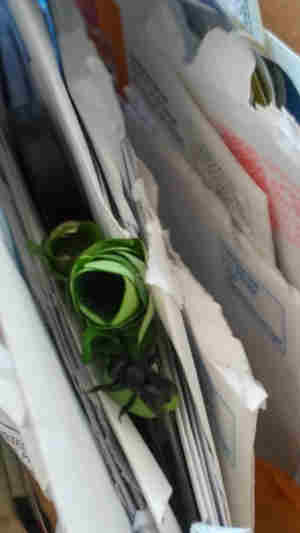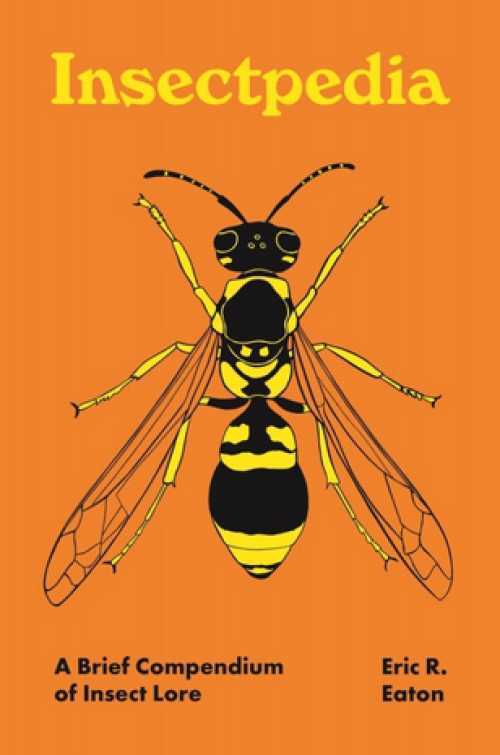Carpenter Bee Or Bumble Bee?
I frequently receive queries regarding bees that are assumed to be bumble bees, but which turn out to be carpenter bees. Indeed, they can look similar, especially considering the size and shape. So is it a bumble bee or a carpenter bee? Here are some clues.
One of the most commonly encountered bumble bee species in the US, is Bombus impatiens, the common eastern bumble bee.
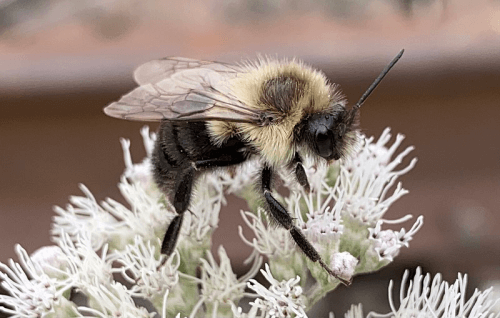 Bombus impatiens, the common eastern bumble bee
Bombus impatiens, the common eastern bumble beeIt so happens, that one of the most frequently seen carpenter bees in the US is called Xylcopa virginica - the eastern carpenter bee.
Not only is the 'common name' similar (though the scientific names are quite different), as can be seen from the photographs, at first glance, they look quite alike. Each has a black abdomen and very pale ginger thorax (upper body), as well as a black head.
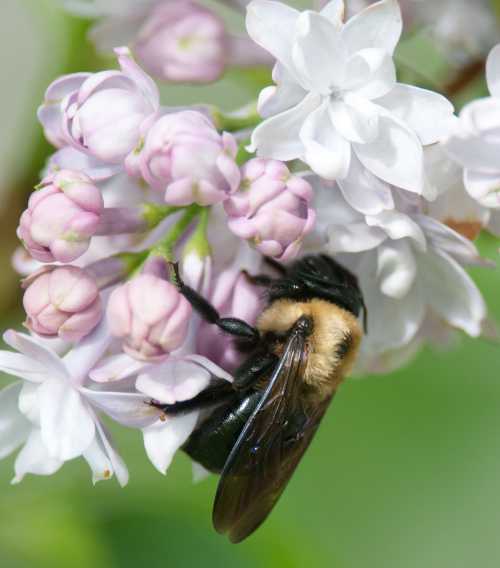 Xylcopa virginica - the eastern carpenter bee
Xylcopa virginica - the eastern carpenter beeCarpenter Bee Or Bumble Bee - Key I.D. Tips
There are of course, different species of carpenter and bumble bee, but in general, here are some characteristics:
1. Nest activity
If the bee is flying in and out of a neat, round hole (a tunnel entrance) in a piece of wood, it's a carpenter bee. Read about carpenter bee nests.
However, if the bee has made a nest in a pre-formed cavity (for example, is seen flying in and out of the entrance of a bird house), it's a bumble bee.
Carpenter bees tunnel into wood (or sometimes make nests in hollow reeds and bamboo canes), and whilst bumble bees may nest around wood (such as under the decking, beneath a wooden shed, or in the eaves of a house) they don't gnaw into wood. Read about bumble bee nests.
2. Appearance
If the bee is dark and has a metallic hue to the body or wings, it's a carpenter bee, although species vary.
If the bee has a full hairy thorax (upper body) and shiny dark abdomen, again it is likely to be a carpenter species.
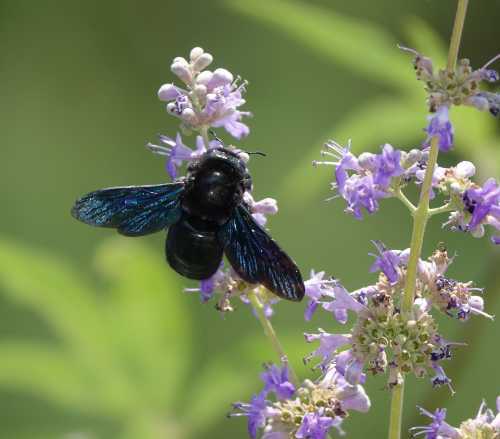 Carpenter bee (possibly a Violet carpenter).
Carpenter bee (possibly a Violet carpenter).There are exceptions, however. The male of the western carpenter bee, Xylocopa varipunctata has golden ginger hair although the eyes have a greenish tinge.
Bees with multiple colored bands (e.g. a black body, with yellow, rust/orangey, or white bands, are likely to be bumble bees.
3. Pollen Collection
Whilst males of neither species collect pollen, females do, and if the bee is foraging, it's a good idea to check whether pollen is being collected during the foraging trip, and if so, how the pollen is being collected.
Bumble bees are corbiculate1 - that is, they collect pollen in pollen baskets (corbiculae) on their hind legs, and pollen takes on a roundish, more compact appearance.
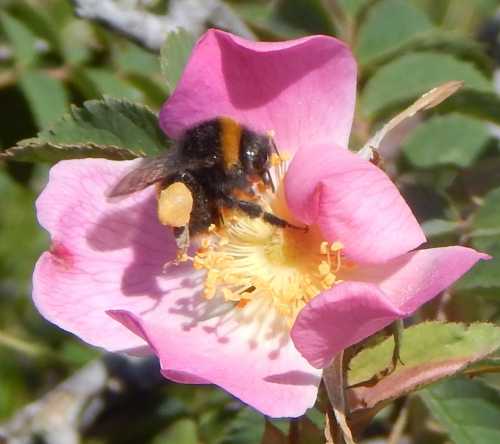 Bumble bee showing pollen basket on the hind leg.
Bumble bee showing pollen basket on the hind leg.In contrast, carpenter bees use long hairs (scopa) to carry pollen, and pollen is looser in appearance, covering the whole leg when laden with pollen.
Carpenter bee vs bumble bee
There are a number of similarities and differences between carpenter bees and bumble bees, outlined here for general information.
Key Similarities
Bee family
Both belong to the bee family Apidae and to the long-tongued category.
Pollination
Both groups of species are able to buzz pollinate.
Carpenter bee vs bumble bee stings
The toxicity of bee stings and their associated pain levels have been the subject of research, and of the species tested, carpenter bees and bumble bees were found to have a similar pain and toxicity range.
Size
Both carpenter and bumble bees can be quite large, and reach a size of about an inch, according to Wilson & Messinger Carril authors of 'The Bees In Your Backyard'.
Key Differences
Egg laying
In carpenter bees female average
fecundity is very low (7.43 eggs per nest), despite considerable
maternal investment2.
Whilst bumble bee colony sizes vary, bumble bee queens lay more eggs than carpenter bees - indeed, a single egg cup can contain as many eggs as a carpenter (Xylocopa) species may lay in an entire nest - for example between 8 and 12 eggs per egg cup, according to one study3.
Egg size
Bumble bee eggs measure around 2 - 4 mm in length.
In comparison, carpenter bee eggs are renowned for being large within the insect order, Hymenoptera.
Studies describe carpenter bee eggs as "giant-sized", and the eggs may be 9-12 mm in length2.
Life cycle and colony behavior
For differences in life cycle and colony behavior, see my general information page about carpenter bees.
This can then be compared with my description of the bumble bee life cycle.
References
1. Corbiculate Bees. / Engel, Michael S.; Rasmussen, Claus. Encyclopedia of Social Insects. ed. / Christopher K. Starr. Cham : Springer, 2020.
2. Salvatore Vicidomini (1996) Biology of Xylocopa violacea (Hymenoptera): In‐nest ethology, Italian Journal of Zoology, 63:3, 237-242, DOI: 10.1080/11250009609356139
3. Chemical recognition signals on the surface of eggs of the bumblebee Bombus terrestris (Hymenoptera: Apidae), Vera Zamoscik, February 2007.
